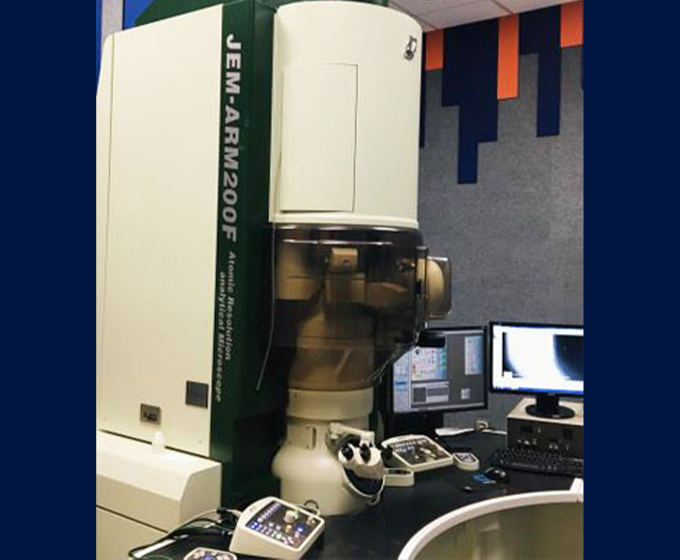
JUNE 26, 2020 — Over the past decade UTSA has experienced explosive growth in the areas of research and acquisition of technology. This period of expansion began in 2010 with a $1.2 million gift from the Robert J. Kleberg Jr. and Helen C. Kleberg Foundation for a JEOL-brand aberration-corrected scanning transmission electron microscope, model JEM-ARM200F, nicknamed Helenita after Helen Kleberg.
The electron microscope, one of the most powerful on earth, is housed in the Kleberg Advanced Microscopy Center on Main Campus. The primary mission of the center is to study materials across multiple disciplines through microscopy, analysis and imaging support for researchers and students within The University of Texas System and other academic institutions in Texas.
The Kleberg center houses numerous instruments, including scanning electron microscopes, spectrometers and X-ray diffractometers. Helenita was the seventh instrument to be added to the collection.
Currently, KAMC is mainly used for scholarly discoveries but also can be used for corporate research and development of micro-electro-mechanical systems, nanosensors, semiconductors, aerospace, energy and life sciences.
“We offer comprehensive training programs for researchers, including students, on our electron microscopes and other advanced equipment,” said Kelly Nash, director for the KAMC and an associate professor of physics at UTSA. “We aim to establish cross-campus collaborative research. KAMC strongly participates in outreach directed toward various community groups, K–12 and other higher education institutions.
One example of this community outreach happens every fall, when the center hosts students from the Advanced Materials Technology Program at Northwest Vista College. The KAMC provides a hands-on opportunity to work and learn about various microscopes, X-ray diffraction spectroscopy and raman spectroscopy.
Due to the pandemic, the KAMC temporarily closed. However, the scientists at the center are now preparing to reopen with the hopes of supporting continued and new research areas.
“We are especially preparing to be a resource to those investigators who may be tackling the challenges presented by COVID-19,” said Nash.
The KAMC is a world-class materials characterization center with the mission to not only foster collaborative research in materials characterization between UTSA and other research institutions but also provide hands-on training to students. The opportunity for researchers, particularly students to gain hands-on experience remains unique to the KAMC, compared to other electron microscopy centers across the country.
UTSA Today is produced by University Communications and Marketing, the official news source of The University of Texas at San Antonio. Send your feedback to news@utsa.edu. Keep up-to-date on UTSA news by visiting UTSA Today. Connect with UTSA online at Facebook, Twitter, Youtube and Instagram.
Move In To COLFA is strongly recommended for new students in COLFA. It gives you the chance to learn about the Student Success Center, campus resources and meet new friends!
Academic Classroom: Lecture Hall (MH 2.01.10,) McKinney Humanities BldgWe invite you to join us for Birds Up! Downtown, an exciting welcome back event designed to connect students with the different departments at the Downtown Campus. Students will have the opportunity to learn about some of the departments on campus, gain access to different resources, and collect some giveaways!
Bill Miller PlazaCome and celebrate this year's homecoming at the Downtown Campus with food, games, giveaways, music, and more. We look forward to seeing your Roadrunner Spirit!
Bill Miller PlazaThe University of Texas at San Antonio is dedicated to the advancement of knowledge through research and discovery, teaching and learning, community engagement and public service. As an institution of access and excellence, UTSA embraces multicultural traditions and serves as a center for intellectual and creative resources as well as a catalyst for socioeconomic development and the commercialization of intellectual property - for Texas, the nation and the world.
To be a premier public research university, providing access to educational excellence and preparing citizen leaders for the global environment.
We encourage an environment of dialogue and discovery, where integrity, excellence, respect, collaboration and innovation are fostered.